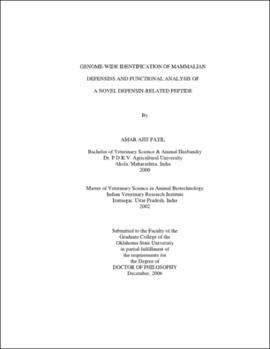| dc.contributor.advisor | Zhang, Guolong | |
| dc.contributor.author | Patil, Amar Ajit | |
| dc.date.accessioned | 2013-11-26T08:22:37Z | |
| dc.date.available | 2013-11-26T08:22:37Z | |
| dc.date.issued | 2006-12 | |
| dc.identifier.uri | https://hdl.handle.net/11244/6615 | |
| dc.description.abstract | Scope and Method of Study: The purpose of this study was to identify novel antimicrobial defensins encoded in the genomes of evolutionarily diverse species such as dog, rat, mouse, human and chimpanzee. Our hypothesis was that identification of novel genes will help us to understand the evolution of this important gene family and provide novel antimicrobial candidates. Genome-wide computational searches of various mammals were conducted to identify the defensin genes using known defensins as query. Further, a novel defensin-related sequence named rattusin with a unique cysteine-spacing pattern was synthesized and evaluated for its antibacterial activity to test the hypothesis that it possesses a unique antibacterial activity. Its precursor peptide was also produced recombinantly and tested against pathogenic bacteria. In addition, the gene expression of rattusin was studied across the entire gastrointestinal tract. | |
| dc.description.abstract | Findings and Conclusions: A large number of defensins were found. a-defensin genes were present only in primates and glires, whereas B-defensins genes were identified in all species studied. Computational mapping revealed that all a- and B-defensin genes were clustered on syntenic chromosomes across all species with 4 clusters in each species, except that humans have 5 clusters. Phylogenetic and evolutionary analysis revealed that a-defensin were subjected to rapid evolution and diversification. a-defensin genes were primarily expressed in bone marrow and small intestine, whereas B-defensin genes were mainly expressed in the male reproductive tract. A novel a-defensin-related gene rattusin was identified in rat. This gene displayed a preferential expression in the distal small intestine. Precursor of rattusin did not exhibit significant antibacterial activity, but the C-terminal putatively mature antibacterial peptide showed potent, broad spectrum, salt insensitive antibacterial activity in contrast to cryptdin-4 and human defensin5. Rattusin also maintained antibacterial activity in the presence of divalent cation, Mg^++ . Rattusin showed no cytotoxicity to intestinal epithelial cells. Thus, rattusin represents a potential antimicrobial drug to treat infections. | |
| dc.format | application/pdf | |
| dc.language | en_US | |
| dc.rights | Copyright is held by the author who has granted the Oklahoma State University Library the non-exclusive right to share this material in its institutional repository. Contact Digital Library Services at lib-dls@okstate.edu or 405-744-9161 for the permission policy on the use, reproduction or distribution of this material. | |
| dc.title | Genome-wide identification of mammalian defensins and functional analysis of a novel defensin-related peptide | |
| dc.contributor.committeeMember | Krehbiel, Clinton | |
| dc.contributor.committeeMember | Jiang, Haobo | |
| dc.contributor.committeeMember | Liu, Lin | |
| osu.filename | Patil_okstate_0664D_2139.pdf | |
| osu.accesstype | Open Access | |
| dc.type.genre | Dissertation | |
| dc.type.material | Text | |
| thesis.degree.discipline | Animal Science | |
| thesis.degree.grantor | Oklahoma State University | |
